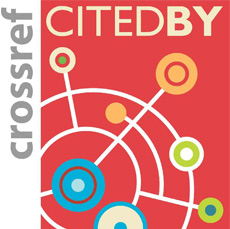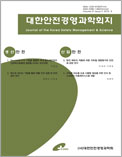ISSN : 2288-1484(Online)
DOI : http://dx.doi.org/10.12812/ksms.2022.24.1.021
“Servant Leadership Makes Safety” : The Effect of Job Insecurity on Safety Behavior
Abstract
“서번트 리더십이 안전을 만든다.” : 고용 불안정성이 안전 행동에 미치는 영향
초록
1. 서 론
2. 이론적 배경
2.1 고용 불안정성과 직무 스트레스, 안전 행동, 그리고 서번트 리더십에 대한 이론적 배경 고찰
2.1.1 고용 불안정성과 안전 행동 사이를 매개 하는 직무 스트레스
2.1.2 고용 불안정성과 직무 스트레스 사이를 조절하는 서번트 리더십
2.2 연구 가설 설정
3. 연구 방법
3.1 연구 대상 및 조사 방법
3.2 자료 분석 방법
3.2.1 측정 도구
4. 조사 결과의 분석
4.1 주요 변인들의 평균, 표준편차 및 변인들 간의 상관관계
4.2 가설 검증
4.2.1 측정 모형 검증
4.2.2 구조 모형 검증
4.2.2.1 매개 모형의 검증
4.2.2.2 매개 모형의 간접 효과 유의성 분석
4.2.2.3 서번트 리더십의 조절 효과 분석
5. 결론 및 논의
Figure
Table
Reference
- [1] W. W. Heinrich(1931), Industrial accident prevention. McGraw-Hill, New York.
- [2] F. E. Bird, F. Cecchi, A. Tilche, J. Mata-Alvarez (1974), Management guide to loss control. Institute Press.
- [3] M. J. Burke, S. A. Sarpy, P. E. Tesluk, K. Smith-Crowe(2002), “General safety performance: A test of a grounded theoretical model.” Personnel Psychology, 55(2):429-457.

- [4] M. S. Christian, J. C. Bradley, J. C. Wallace, M. J. Burke(2009), “Workplace safety: A meta-analysis of the roles of person and situation factors.” Journal of Applied Psychology, 94(5):1103-1127.

- [5] M. A. Griffin, A. Neal(2000), “Perceptions of safety at work: A framework for linking safety climate to safety performance, knowledge, and motivation.” Journal of Occupational Health Psychology, 5(3): 347-358.

- [6] A. B. Bakker, E. Demerouti(2007), “The job demands –resources model: State of the art.” Journal of Managerial Psychology, 22:309–328.

- [7] E. Demerouti, A. B. Bakker, F. Nachreiner, W. B. Schaufeli(2001), “The job demands–resources model of burnout.” Journal of Applied Psychology, 86:499–512.

- [8] N. De Cuyper, A. Makikangas, U. Kinnunen, S. Mauno, H. De Witte(2012), “Cross-lagged associations between perceived external employability, job insecurity, and exhaustion: Testing gain and loss spirals according to the conservation of resources theory.” Journal of Organizational Behavior, 33: 770-788.

- [9] G. H. Cheng, D. Chan(2008), “Who suffers more from job insecurity? A meta-analytic review.” Applied Psychology, 57:272-303.

- [10] J. Ferrie, M. Shipley, M. Marmot, P. Martikainen, S. Stansfeld, G. Smith(2001), “Job insecurity in white-collar workers: Toward an explanation of association with health.” Journal of Occupational Health Psychology, 6:26-42.

- [11] S. Gilboa, A. Shirom, Y. Fried, C. Cooper(2008), “A meta‐analysis of work demand stressors and job performance: Examining main and moderating effects.” Personnel Psychology, 61(2):227-271.

- [12] B. J. Kim(2019), “Unstable jobs cannot cultivate good rganizational citizens: The sequential mediating role of organizational trust and identification.” International Journal of Environmental Research and Public Health, 16(7):1102.

- [13] B. J. Kim(2020), “Unstable jobs harm performance: The importance of psychological safety and organizational commitment in employees.” SAGE Open, 10(2):2158244020920617.

- [14] C. Niessen, N. L. Jimmieson(2016), “Threat of resource loss: The role of self-regulation in adaptive task performance.” Journal of Applied Psychology, 101:450-462.

- [15] T. M. Probst, S. M. Stewart, M. L. Gruys, B. W. Tierney(2007), “Productivity, counterproductivity and creativity: The ups and downs of job insecurity.” Journal of Occupational and Organizational Psychology, 80:479-497.

- [16] A. Richter, K. Naswall(2019), “Job insecurity and trust: Uncovering a mechanism linking job insecurity to well-being.” Work & Stress, 33(1): 22–40.

- [17] Y. Shin, W. M. Hur, T. W. Moon, S. Lee(2019), “A motivational perspective on job insecurity: Relationships between job insecurity, intrinsic motivation, and performance and behavioral outcomes.” International Journal of Environmental Research and Public Health, 16(10):1812.

- [18] M. K. Shoss(2017), “Job insecurity: An integrative review and agenda for future research.” Journal of Management, 43(6):1911–1939.

- [19] H. J. Wang, C. Q. Lu, O. L. Siu(2015), “Job insecurity and job performance: The moderating role of organizational justice and the mediating role of work engagement.” Journal of Applied Psychology, 100(4):1249–1258.

- [20] S. W. Lee, B. J. Kim(2021), ““The importance of servant leader”: The influence of job insecurity on innovative behavior, the mediating effect of basic psychological need satisfaction and moderating effect of servant leadership.” Journal of CEO and Management Studies, 24(1):31-50.

- [21] R. C. Liden, S. J. Wayne, H. Zhao, D. Henderson (2008), “Servant leadership: Development of a multidimensional measure and multi-level assessment.” The Leadership Quarterly, 19(2): 161–17.

- [22] D. L. Parris, J. W. Peachey(2013), “A systematic literature review of servant leadership theory in organizational contexts.” Journal of Business Ethics, 113(3):377-393.

- [23] D. Van Dierendonck(2011), “Servant leadership: A review and synthesis.” Journal of Management, 37(4):1228-1261.

- [24] J. Barling, E. K. Kelloway(1996), “Job insecurity and health: The moderating role of workplace control.” Stress Medicine, 12:253-259.

- [25] G. H. L. Cheng, D. K. S. Chan(2008), “Who suffers more from job insecurity? A meta-analytic review.” Applied Psychology: An International Review, 57:272-303.

- [26] H. De Witte(1999), “Job insecurity and psychological well-being: Review of the literature and exploration of some unresolved issues.” European Journal of Work and Organizational Psychology, 8:155-177.

- [27] H. De Witte, J. Pienaar, N. De Cuyper(2016), “Review of 30 years of longitudinal studies on the association between job insecurity and health and well‐being: Is there causal evidence?” Australian Psychologist, 51(1):18-31.

- [28] L. Jiang, T. M. Probst(2014), “Organizational communication: A buffer in times of job insecurity?” Economic and Industrial Democracy, 35:557-579.

- [29] B. Schreurs, H. Van Emmerik, G. Notelaers, H. De Witte(2010), “Job insecurity and employee health: The buffering potential of job control and job self-efficacy.” Work & Stress, 24:56-72.

- [30] E. L. Deci, R. M. Ryan, M. Gagne, D. R. Leone, J. Usunov, B. P. Kornazheva(2001), “Need satisfaction, motivation, and well-being in the work organizations of a former eastern bloc country: A cross-cultural study of self-determination.” Personality and Social Psychology Bulletin, 27(8): 930-942.

- [31] T. Vander Elst, A. Van den Broeck, H. De Witte, N. De Cuyper(2012), “The mediating role of frustration of psychological needs in the relationship between job insecurity and work-related well-being.” Work & Stress, 26(3):252-271.

- [32] D. W. Go, S. Y. Jung, B. J. Kim(2016), “”Trust makes safety”: The effect of workload on safety behavior.” Journal of Korea Safety Management Science, 18(1):131-140.

- [33] S. Y. Jung, B. J. Kim, D. W. Go(2016), “A effect of physical environment on safety behavior: Mediation of job stress, and moderation of safety climate.” Journal of Korea Safety Management Science, 18(1):89-97.

- [34] S. Clarke(2006), “The relationship between safety climate and safety performance: A meta-analytic review.” Journal of Occupational Health Psychology, 11(4):315-327.

- [35] A. Neal, M. A. Griffin(2006), “A study of the lagged relationships among safety climate, safety motivation, safety behavior, and accidents at the individual and group levels.” Journal of Applied Psychology, 91(4):946-953.

- [36] S. Gilboa, A. Shirom, Y. Fried, C. Cooper(2008), “A meta‐analysis of work demand stressors and job performance: Examining main and moderating effects.” Personnel Psychology, 61(2):227-271.

- [37] J. M. Sampson, S. DeArmond, P. Y. Chen(2014), “Role of safety stressors and social support on safety performance.” Safety Science, 64:137-145.

- [38] J. C. Wallace, B. D. Edwards, T. Arnold, M. L. Frazier, D. M. Finch(2009), “Work stressors, role-based performance, and the moderating influence of organizational support.” Journal of Applied Psychology, 94(1):254-262.

- [39] S. Sonnentag, M. Frese(2003), “Stress in organizations.” In W. C. Borman, D. R. Ilgen & R. J. Klimoski (Eds.), Comprehensive handbook of psychology (vol. 12, pp. 453-491). Industrial and Organizational Psychology, Wiley, New York, NY.
- [40] B. D. Steffy, J. W. Jones, L. R. Murphy, L. Kunz(1986), “A demonstration of the impact of stress abatement programs on reducing employees' accidents and their costs.” American Journal of Health Promotion, 1(2):25-32.

- [41] K. B. Lowe, K. G. Kroeck, N. Sivasubramaniam (1996), “Effectiveness correlates of transformational and transactional leadership: A meta-analytic review of the MLQ literature.” The Leadership Quarterly, 7(3):385-425.

- [42] E. H. Schein(2004), Organizational culture and leadership (3rd ed). San Francisco: Jossey Bass.
- [43] J. E. Barbuto Jr., D. W. Wheeler(2006), “Scale development and construct clarification of servant leadership.” Group & Organization Management, 31(3):300-326.

- [44] E. M. Hunter, M. J. Neubert, S. J. Perry, L. A. Witt, L. M. Penney, E. Weinberger(2013), “Servant leaders inspire servant followers: Antecedents and outcomes for employees and the organization.” The Leadership Quarterly, 24(2):316–331.

- [45] J. Hu, R. C. Liden(2011), “Antecedents of teampotency and team effectiveness: An examination of goal and process clarityand servan leadership.” Journal of Applied Psychology, 96(4):851–862.

- [46] M. J. Neubert, K. M. Kacmar, D. S. Carlson, L. B. Chonko, J. A. Roberts(2008), “Regulatory focus as a mediator of the influence of initiating structure and servant leadership on employee behavior.” Journal of Applied Psychology, 93(6):1220-1233.

- [47] P. E. Shrout, N. Bolger(2002), “Mediation in experimental and nonexperimental studies: New procedures and recommendations.” Psychological Methods, 7(4):422-445.

- [48] L. T. Hu, P. M. Bentler(1999), “Cutoff criteria for fit indexes in covariance structure analysis: Conventional criteria versus new alternatives.” Structural Equation Modeling: A Multidisciplinary Journal, 6(1):1-55.

- [49] M. L. Kraimer, S. J. Wayne, R. C. Liden, R. T. Sparrowe(2005), “The role of job security in understanding the relationship between employees’ perceptions of temporary workers and employees' performance.” Journal of Applied Psychology, 90(2):389–398.

- [50] S. J. Motowidlo, J. S. Packard, M. R. Manning(1986), “Occupational stress: Its causes and consequences for job performance.” Journal of Applied Psychology, 71(4):618-629.

- [51] J. Anderson, D. Gerbing(1988), “Structural equation modeling in practice: A review and recommended two-step approach.” Psychological Bulletin, 103(3):411-423.

- [52] A. F. Hayes, K. J. Preacher(2013), “Conditional process modeling: Using structural equation modeling to examine contingent causal processes.” In G. R. Hancock & R. O. Mueller (Eds.), Structural equation modeling: A second course (pp. 219–266). IAP Information Age Publishing.
-
-
Online Submission
http://submission.koreasafety.or.kr
-
KSSM
The Korean Society of Safety ManagementWaste Society
-
Editorial Office
Contact Information- Tel: +82.31.336.2844
- Fax: +82.31.336.2845
- E-mail: safety@mju.ac.kr -

-

-

-

-

-

-







